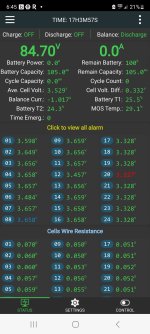I have a 16s 105ah lifepo4 build that I have about 5 cycles on. I've since added to the pack and upgraded it to a 24s.
The new cells were sitting at 3.27v so I depleted the 16s pack down until all the cells were resting at 3.27v. Then built it to a 24s. Everything was charging up good in balance but now the new cells are far off. Any recommendations on how to remedy this situation besides bottom balance? Will the active balancer I'm the jk bms correct it over time? Thanks in advance
The new cells were sitting at 3.27v so I depleted the 16s pack down until all the cells were resting at 3.27v. Then built it to a 24s. Everything was charging up good in balance but now the new cells are far off. Any recommendations on how to remedy this situation besides bottom balance? Will the active balancer I'm the jk bms correct it over time? Thanks in advance


